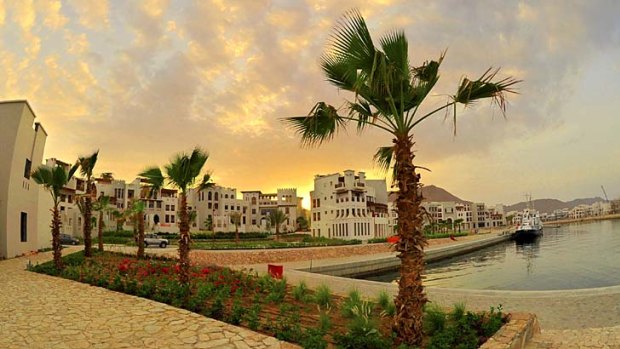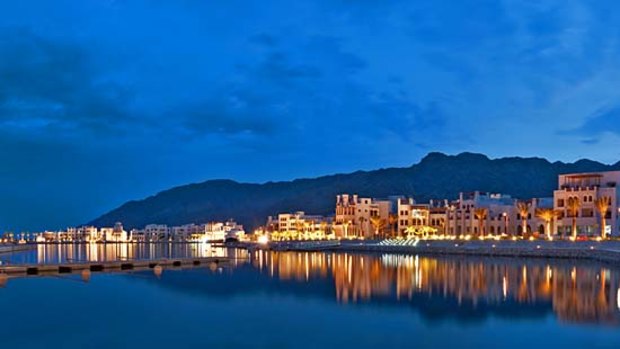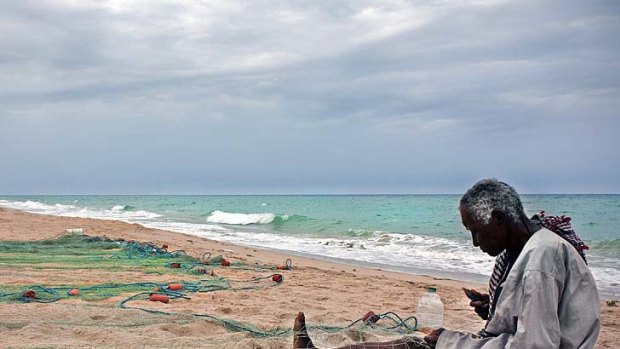
A different world ... the tourism complex itself.
Lance Richardson explores the latest mega-development in the Middle East.
When world financial markets crashed in 2008, few places experienced the crisis as physically as the Middle East. Tower cranes fell silent over abandoned construction sites, more akin to grave markers than symbols of prosperity.
In Dubai, the casualties were as numerous as they were extravagant. The Anara Tower was to soar some 600 metres, with a sky garden every 27 floors. Most ambitious of all, The World dredged sand from the coast into a vast network of artificial islands resembling - yes, the world. The islands were completed in 2008, and virtually nobody has built on them since.

Mega-project ... Jebel Sifah.
Not everything fell by the wayside. Abu Dhabi is still slated to get its Guggenheim, designed by Frank Gehry to be the largest in the world. A new Louvre museum, resembling a flying saucer full of holes, is being built nearby on the coming cultural district of Saadiyat Island.
Also continuing to push the envelope in development is the country of Oman, bordering the United Arab Emirates to the east. Though it experienced setbacks of its own due to the global financial crisis, co-operation between the Omani government and private developers means it is still business as usual for at least one aspiring destination on the Arabian Gulf.
Jebel Sifah is an "Integrated Tourism Complex", which means it's a self-contained destination for travellers and resident Omanis wanting to live in the luxury of an endless holiday. Encompassing everything from restaurants to water sports and private beaches, its seclusion is also its drawcard.
At first sight, Jebel Sifah rises like an unexpected oasis.
It is 45 minutes from the capital, Muscat, sandwiched between rock and the ocean. Indeed, a water taxi, leaving from a marina just behind Muscat's Flag Palace, traces a coastline of formidable cliffs, an alternative form of approach from the road that threads through the dramatic Hajar Mountains. Braids of algae float in the water here, disrupted by pods of playful dolphins that sometimes number in the hundreds.
At first sight, Jebel Sifah rises from the barren landscape like an unexpected oasis: white buildings, built in Omani style, cluster around another marina, with palm trees and mooring lines for yachts.
This is Marina Town, the social hub of Jebel Sifah. People eat in outdoor restaurants; others lounge in an open tent stuffed with pillows. Arriving by boat, the development strikes a visitor for its tasteful modesty - we are a far cry from the overt extravagance of the Burj Khalifa, for example.

A fisherman tends his nets at Jebel Sifah on the Omani coast.
The style of Jebel Sifah is thanks in large part to governmental restrictions on colour and size; Oman values its distinctive aesthetic traditions. However, "modest" does not necessarily mean "small" - step past Marina Town and the complex sprawls for 6.2 million square metres down the coast.
Marina Town officially opened in March and its many retail venues are now ready for tenants. Eighteen apartment blocks are similarly prepared, and a freehold law allows foreign ownership, should somebody decide to stay longer.
Still to come on the vast but quickly altering construction site are some 950 villas - a few are already completed and dot the landscape - and an 18-hole PGA golf course designed by Peter Harradine.
Then, of course, there are the hotels. At present, the Jebel Sifah complex has a single hotel, the well-appointed Sifawy Boutique in the heart of Marina Town.
With 55 guest rooms, Sifawy prioritises service over size. Rooms are knitted together like honeycomb, though each includes a private balcony. The hotel also arranges dolphin cruises, desert excursions, scuba-diving and fishing trips. But like an entree before an expansive main, Sifawy is only the projected start.
Missoni, an Italian fashion house based in Varese, has committed to building a hotel here, designed by Michael Graves and decorated by Rosita Missoni herself. It will be joined by a Banyan Tree Hotel, prioritising eco-friendly luxury across 239 rooms and 77 units.
The beach, however, will go to the Four Seasons: designed by the Mexican architect Diego Villasenor, it will offer another 200 rooms and 70 units.
"When Aladdin invited Jasmine on a carpet ride they must have glided through the starry skies of Jebel Sifah," the project's website says. While the full extent of Jebel Sifah's star power remains to be seen, the ride is off to a promising start.
The writer travelled courtesy of the Sultanate of Oman and Etihad Airways.
Trip notes
Getting there
Etihad Airways flies to Muscat from Sydney daily, with a transfer in Abu Dhabi. Prices start from $1831 a person. etihadairways.com.
Jebel Sifah is 45 minutes on the road through the Hajar Mountains, or via water taxi from Muscat's marina.
Staying there
The Sifawy Boutique Hotel offers 25 rooms and 30 suites, each with a balcony overlooking the private marina and Gulf of Oman. Prices start at 70 rial ($184) a night. sifawyhotel.com.
More information
Sign up for the Traveller Deals newsletter
Get exclusive travel deals delivered straight to your inbox. Sign up now.